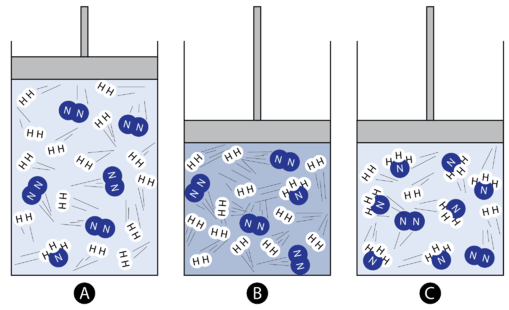19.8: Effect of Pressure
- Page ID
- 53911
\( \newcommand{\vecs}[1]{\overset { \scriptstyle \rightharpoonup} {\mathbf{#1}} } \)
\( \newcommand{\vecd}[1]{\overset{-\!-\!\rightharpoonup}{\vphantom{a}\smash {#1}}} \)
\( \newcommand{\dsum}{\displaystyle\sum\limits} \)
\( \newcommand{\dint}{\displaystyle\int\limits} \)
\( \newcommand{\dlim}{\displaystyle\lim\limits} \)
\( \newcommand{\id}{\mathrm{id}}\) \( \newcommand{\Span}{\mathrm{span}}\)
( \newcommand{\kernel}{\mathrm{null}\,}\) \( \newcommand{\range}{\mathrm{range}\,}\)
\( \newcommand{\RealPart}{\mathrm{Re}}\) \( \newcommand{\ImaginaryPart}{\mathrm{Im}}\)
\( \newcommand{\Argument}{\mathrm{Arg}}\) \( \newcommand{\norm}[1]{\| #1 \|}\)
\( \newcommand{\inner}[2]{\langle #1, #2 \rangle}\)
\( \newcommand{\Span}{\mathrm{span}}\)
\( \newcommand{\id}{\mathrm{id}}\)
\( \newcommand{\Span}{\mathrm{span}}\)
\( \newcommand{\kernel}{\mathrm{null}\,}\)
\( \newcommand{\range}{\mathrm{range}\,}\)
\( \newcommand{\RealPart}{\mathrm{Re}}\)
\( \newcommand{\ImaginaryPart}{\mathrm{Im}}\)
\( \newcommand{\Argument}{\mathrm{Arg}}\)
\( \newcommand{\norm}[1]{\| #1 \|}\)
\( \newcommand{\inner}[2]{\langle #1, #2 \rangle}\)
\( \newcommand{\Span}{\mathrm{span}}\) \( \newcommand{\AA}{\unicode[.8,0]{x212B}}\)
\( \newcommand{\vectorA}[1]{\vec{#1}} % arrow\)
\( \newcommand{\vectorAt}[1]{\vec{\text{#1}}} % arrow\)
\( \newcommand{\vectorB}[1]{\overset { \scriptstyle \rightharpoonup} {\mathbf{#1}} } \)
\( \newcommand{\vectorC}[1]{\textbf{#1}} \)
\( \newcommand{\vectorD}[1]{\overrightarrow{#1}} \)
\( \newcommand{\vectorDt}[1]{\overrightarrow{\text{#1}}} \)
\( \newcommand{\vectE}[1]{\overset{-\!-\!\rightharpoonup}{\vphantom{a}\smash{\mathbf {#1}}}} \)
\( \newcommand{\vecs}[1]{\overset { \scriptstyle \rightharpoonup} {\mathbf{#1}} } \)
\( \newcommand{\vecd}[1]{\overset{-\!-\!\rightharpoonup}{\vphantom{a}\smash {#1}}} \)
\(\newcommand{\avec}{\mathbf a}\) \(\newcommand{\bvec}{\mathbf b}\) \(\newcommand{\cvec}{\mathbf c}\) \(\newcommand{\dvec}{\mathbf d}\) \(\newcommand{\dtil}{\widetilde{\mathbf d}}\) \(\newcommand{\evec}{\mathbf e}\) \(\newcommand{\fvec}{\mathbf f}\) \(\newcommand{\nvec}{\mathbf n}\) \(\newcommand{\pvec}{\mathbf p}\) \(\newcommand{\qvec}{\mathbf q}\) \(\newcommand{\svec}{\mathbf s}\) \(\newcommand{\tvec}{\mathbf t}\) \(\newcommand{\uvec}{\mathbf u}\) \(\newcommand{\vvec}{\mathbf v}\) \(\newcommand{\wvec}{\mathbf w}\) \(\newcommand{\xvec}{\mathbf x}\) \(\newcommand{\yvec}{\mathbf y}\) \(\newcommand{\zvec}{\mathbf z}\) \(\newcommand{\rvec}{\mathbf r}\) \(\newcommand{\mvec}{\mathbf m}\) \(\newcommand{\zerovec}{\mathbf 0}\) \(\newcommand{\onevec}{\mathbf 1}\) \(\newcommand{\real}{\mathbb R}\) \(\newcommand{\twovec}[2]{\left[\begin{array}{r}#1 \\ #2 \end{array}\right]}\) \(\newcommand{\ctwovec}[2]{\left[\begin{array}{c}#1 \\ #2 \end{array}\right]}\) \(\newcommand{\threevec}[3]{\left[\begin{array}{r}#1 \\ #2 \\ #3 \end{array}\right]}\) \(\newcommand{\cthreevec}[3]{\left[\begin{array}{c}#1 \\ #2 \\ #3 \end{array}\right]}\) \(\newcommand{\fourvec}[4]{\left[\begin{array}{r}#1 \\ #2 \\ #3 \\ #4 \end{array}\right]}\) \(\newcommand{\cfourvec}[4]{\left[\begin{array}{c}#1 \\ #2 \\ #3 \\ #4 \end{array}\right]}\) \(\newcommand{\fivevec}[5]{\left[\begin{array}{r}#1 \\ #2 \\ #3 \\ #4 \\ #5 \\ \end{array}\right]}\) \(\newcommand{\cfivevec}[5]{\left[\begin{array}{c}#1 \\ #2 \\ #3 \\ #4 \\ #5 \\ \end{array}\right]}\) \(\newcommand{\mattwo}[4]{\left[\begin{array}{rr}#1 \amp #2 \\ #3 \amp #4 \\ \end{array}\right]}\) \(\newcommand{\laspan}[1]{\text{Span}\{#1\}}\) \(\newcommand{\bcal}{\cal B}\) \(\newcommand{\ccal}{\cal C}\) \(\newcommand{\scal}{\cal S}\) \(\newcommand{\wcal}{\cal W}\) \(\newcommand{\ecal}{\cal E}\) \(\newcommand{\coords}[2]{\left\{#1\right\}_{#2}}\) \(\newcommand{\gray}[1]{\color{gray}{#1}}\) \(\newcommand{\lgray}[1]{\color{lightgray}{#1}}\) \(\newcommand{\rank}{\operatorname{rank}}\) \(\newcommand{\row}{\text{Row}}\) \(\newcommand{\col}{\text{Col}}\) \(\renewcommand{\row}{\text{Row}}\) \(\newcommand{\nul}{\text{Nul}}\) \(\newcommand{\var}{\text{Var}}\) \(\newcommand{\corr}{\text{corr}}\) \(\newcommand{\len}[1]{\left|#1\right|}\) \(\newcommand{\bbar}{\overline{\bvec}}\) \(\newcommand{\bhat}{\widehat{\bvec}}\) \(\newcommand{\bperp}{\bvec^\perp}\) \(\newcommand{\xhat}{\widehat{\xvec}}\) \(\newcommand{\vhat}{\widehat{\vvec}}\) \(\newcommand{\uhat}{\widehat{\uvec}}\) \(\newcommand{\what}{\widehat{\wvec}}\) \(\newcommand{\Sighat}{\widehat{\Sigma}}\) \(\newcommand{\lt}{<}\) \(\newcommand{\gt}{>}\) \(\newcommand{\amp}{&}\) \(\definecolor{fillinmathshade}{gray}{0.9}\)The ammonia storage tank in the picture below does two things. First, it stores ammonia at high pressure to minimize the reverse reaction that would lead to less ammonia, and more nitrogen and hydrogen. Secondly, it sends an important message. Ammonia is used to make methamphetamine, a dangerous drug of abuse. Locks and other safety mechanisms built into the tanks help stop the theft of ammonia to be used for this illicit activity.

Effect of Pressure
Changing the pressure of an equilibrium system in which gases are involved is also a stress to the system. A change in the pressure on a liquid or a solid has a negligible effect. We will return again to the equilibrium for the Haber-Bosch process. Imagine the gases are contained in a closed system in which the volume of the system is controlled by an adjustable piston, as shown in the figure below.

On the far left, the reaction system contains primarily \(\ce{N_2}\) and \(\ce{H_2}\), with only one molecule of \(\ce{NH_3}\) present. As the piston is pushed inwards, the pressure of the system increases according to Boyle's Law. This is a stress to the equilibrium. In the middle image, the same number of molecules is now confined in a smaller space and so the pressure has increased. According to Le Chatelier's principle, the system responds in order to relieve the stress. In the image on the right, the forward reaction has been favored, in which one molecule of \(\ce{N_2}\) combines with three molecules of \(\ce{H_2}\) to form two molecules of \(\ce{NH_3}\). The overall result is a decrease in the number of gas molecules in the entire system. This in turn decreases the pressure and provides a relief to the original stress of a pressure increase. An increase in pressure on an equilibrium system favors the reaction which produces fewer total moles of gas. In this case, it is the forward reaction that is favored.
A decrease in pressure on the above system could be achieved by pulling the piston outward, increasing the container volume. The equilibrium would respond by favoring the reverse reaction in which \(\ce{NH_3}\) decomposes to \(\ce{N_2}\) and \(\ce{H_2}\). This is because the overall number of gas molecules would increase, and so would the pressure. A decrease in pressure on an equilibrium system favors the reaction that produces more total moles of gas. This is summarized in the table below.
| Stress | Response |
|---|---|
| Pressure increase | Reaction produces fewer gas molecules. |
| Pressure decrease | Reaction produces more gas molecules. |
Like changes in concentration, the \(K_\text{eq}\) value for a given reaction is unchanged by a change in pressure.
It is important to remember when analyzing the effect of a pressure change on equilibrium that only gases are affected. If a certain reaction involves liquids or solids, they should be ignored. Calcium carbonate decomposes according to the equilibrium reaction:
\[\ce{CaCO_3} \left( s \right) \rightleftharpoons \ce{CaO} \left( s \right) + \ce{O_2} \left( g \right)\nonumber \]
Oxygen is the only gas in the system. An increase in the pressure of the system slows the rate of decomposition of \(\ce{CaCO_3}\) because the reverse reaction is favored. When a system contains equal moles of gas on both sides of the equation, pressure has no effect on the equilibrium position, as in the formation of \(\ce{HCl}\) from \(\ce{H_2}\) and \(\ce{Cl_2}\).
\[\ce{H_2} \left( g \right) + \ce{Cl_2} \left( g \right) \rightleftharpoons 2 \ce{HCl} \left( g \right)\nonumber \]

